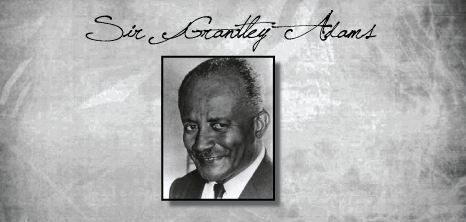|
Sir Grantley Adams (1898 - 1971)Born at Colliston, Government Hill, St. Michael on April 28, 1898 to Fitzherbert Adams and the former Rosa Frances Turney, Grantley Herbert Adams’ birth paved the way by empowering the masses in such a way that brought about social and economic revolution. Educated at St. Giles School and Harrison College in Barbados, he won a scholarship in 1918 and subsequently attended Oxford University in England where he studied Classics and Jurisprudence. Adams was admitted to the Bar at Grey's Inn and functioned as a Counsel of Her Majesty, the Queen of England. He returned to Barbados in 1925, and in 1929 the former Grace Thorne became Mrs. Grantley Adams. Acclaimed a highly respected lawyer, Adams was elected to the House of Assembly in 1934 as a member for St. Joseph, where he was able to proficiently debate on the floor. He returned to office in the 1935 and 1936 General Elections.
After the riots in 1937, following the arrest, trial and deportation of Clement Payne, Adams represented Payne and made an effort to restore order on the island. As a result of the disruption, Adams was sent to England England to inform the Secretary of State for the Colonies, and was first in giving evidence to the Dean Commission of Enquiry into the riots. Here is where he took full advantage of asserting his conviction that was based on the simple principle that had there been social change as opposed to continuous subjection of the masses, there would have never been a riot.
The Birth of the Barbados Labour PartyFocused on the unity of workers, on March 31, 1938, the Barbados Labour Party was formed. Despite his absence from the island, Adams was elected as the first deputy leader and in 1939, he took over leadership of the party.
In 1940, under his leadership, the party (then known as the Barbados Progressive League) won five seats in the House of Assembly. In 1941, the Barbados Workers' Union was formed and Adams was President until 1954.
In 1942, he was appointed a member of the Executive Committee.
In the mid 1940s Adams along with Hugh Worrell Springer, were able to use power and influence due to their membership on the Governor-in-Executive Committee. His pivotal role in the many key changes throughout Barbados are numerous; for example:
The Workmen’s Compensation Act was passed in 1946 while Adams was Leader of the House. The price of progress was evident as Adams tried to accelerate the growth of the country. His personal and professional life came under much fire as bullet holes at his Tyrol Cot home told the story.
Both him and Hugh Springer, and then Frank Walcott, built a unique trade union movement that worked along with the Barbados Labour Party to implement social change. This then resulted in him being able to secure the introduction of Universal Adult Suffrage in 1951 and in 1954, a full ministerial government was introduced, with Adams as first Premier. Some implemented procedures included:
In 1947 in Jamaica, he was elected President of the Caribbean Labour Congress which sought to unite the political Caribbean.
As a result of the instrumental role he played in the development of the International Confederation of Free Trade Unions, Adams was elected one of its three vice-chairmen.
The Birth of the Democratic Labour PartyIn 1954, Frank Walcott broke ties with Grantley Adams and the following year, some members of the Barbados Labour Party left that organisation and formed the Democratic Labour Party with Errol Barrow as leader. In 1958, on his departure to lead the West Indies Federation, Adams appointed Dr. Hugh Gordon Cummins to head the party and be Premier of Barbados in 1958.
On May 31, 1962 after formal dissolution of the regional enterprise on May 31, 1962, Adams returned home and was re-elected to the House of Assembly. In 1966, he assumed the role of Leader of the Opposition where he brought the BLP to the position of a powerful Opposition in the House of Assembly.
In 1970, he resigned from public life as a result of his failing health. He remained Life President of the BLP but assigned responsibilities of leadership to younger men such as H. B. St. John, and J.M.G.M. "Tom" Adams, his son, who in September of 1976, became Prime Minister of Barbados.
On November 28, 1971, he died at the age of 73 and was buried at St. Michael's Cathedral.
The $100 note, which is this island’s largest value of currency carries his portrait and the Sir Grantley Adams International Airport holds his name.
|
|
|


